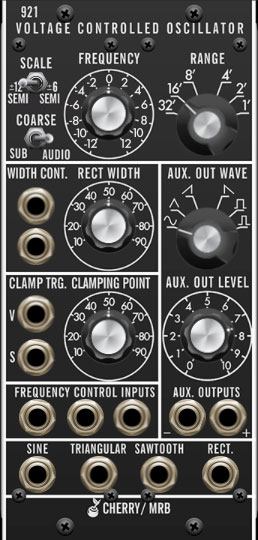
The VM921 is a full-function oscillator module. It can be used in the audio range, or as a low-frequency modulation source.
Inputs, Outputs, and Controls
Scale- Sets the Frequency knob range to +/- 12 or +/- 6 semitones.
Coarse Range- Sets the coarse frequency range to sub-audio or standard audio range. Use the Sub-Audio setting when using VM921 as low-frequency modulation source; use the Audio setting when using as standard audio source.
Frequency- Continuously sets the base oscillator frequency range to +/- 12 or +/- 6 semitones depending on the Scale switch setting.
Range- Sets the base oscillator frequency in standard organ-style footage increments.
Waveform Volume- Sets the volume of the sine, triangle, square, ramp, and pulse waves in the master output. These do not affect volume of the individual wave out jacks.
Rectangular Width (Pulse Width) and Width Control jacks- Sets the width or "duty-cycle" of the rectangular (aka, pulse) wave ( the waveform on bottom right of the panel). It has no effect on any other waveform. Its default setting of 50% outputs a perfect square wave, rich in odd-order harmonics. Moving the knob left or right narrows its width as well as the thickness of sound until it almost disappears at its extremes.
The Width Control In jacks allow CV control of the width of the rectangular (pulse) wave. Both jacks are the same; their input voltages will be summed.
Clamping Point and Clamp Trig. jack- This is commonly known as oscillator sync. Sending a trigger or gate voltage to the Clamp Trig. jack restarts the wave from a point defined by the Clamping Point knob, from 0% to 100% of its cycle. (Incidentally, my family used to vacation at Clamping Point Knob in rural Maine in the 70s, but that's not important right now).
The V input is sensitive to rising edges passing through a +1V threshold. The S input is sensitive to falling edges passing through +1V. This reproduces the logic of S-trigger action without the headache.
Aux. Out. Waveform and Aux. Out. Level- Since all of the waveforms are concurrently available at the bottom jacks, these acts as convenient selectable wave outs with a dedicated volume knob. The right output jack signal is normal, and the left output jack signal is inverted. This section's settings have no effect on the dedicated wave out jacks at the bottom of the module.
Frequency Control Input jacks- Accepts a 1V/oct CV input for pitch or modulation. Typically this would come from the Pitch jack in the IO Panel CV Out section, a sequencer CV out, or a mod source. All three mod input jacks are the same and their CV's are summed.
These mod inputs are exponential, that is, for a given mod input voltage, the mod amount increases as frequency increases. For example, if the base frequency is 1000 Hz, and a bipolar wave is applied to the mod CV input, the frequency falls to 500 Hz and rises to 2000 Hz. Because audio frequencies are inherently exponential in nature, the resulting frequency rises and falls exactly one octave.
Sine/Triangular/Sawtooth/Rectangular output jacks- Output jacks for all oscillator waves. These can be used simultaneously, or in any combination. These are always at full amplitude.